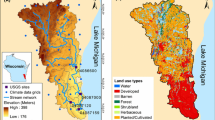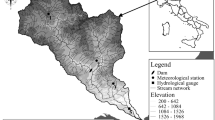Abstract
The impacts of climate change on streamflow in the upper Yangtze River basin were studied using four hydrological models driven by bias-corrected climate projections from five General Circulation Models under four Representative Concentration Pathways. The basin hydrological responses to climate forcing in future mid-century (2036–2065) and end-century (2070–2099) periods were assessed via comparison of simulation results in these periods to those in the reference period (1981–2010). An analysis of variance (ANOVA) approach was used to quantify the uncertainty sources associated with the climate inputs and hydrological model structures. Overall, the annual average discharge, seasonal high flow, and daily peak discharge were projected to increase in most cases in the twenty-first century but with considerable variability between models under the conditions of increasing temperature and a small to moderate increase in precipitation. Uncertainties in the projections increase over the time and are associated with hydrological model structures, but climate inputs represent the largest source of uncertainty in the upper Yangtze projections. This study assessed streamflow projections without considering water management practices within the basin.





Similar content being viewed by others

References
Alfieri L et al (2015) Global warming increases the frequency of river floods in Europe. Hydrol Earth Syst Sci 19:2247–2260
Arnell NW, Gosling SN (2013) The impacts of climate change on river flow regimes at the global scale. J Hydrol 486:351–364
Bao XH, Zhang FQ (2012) Evaluation of NCEP-CFSR, NCEP-NCAR, ERA-interim, and ERA-40 reanalysis datasets against independent sounding observations over the Tibetan plateau. J Clim 26:206–214
Bastola S et al (2011) The role of hydrological modeling uncertainties in climate change impact assessments of Irish river catchments. Adv Water Resour 34:562–576
Bosshard T et al (2013) Quantifying uncertainty sources in an emsemble of hydrological climate-impact projection. Water Resour Res 49:1523–1536
Braud I et al (2010) The use of distributed hydrological models for the Gard 2002 flash flood event: analysis of associated hydrological processes. J Hydrol 394:162–181
Cao LJ et al (2011) Climate change effect on hydrological processes over the Yangtze River basin. Quat Int 244:202–210
Chang H et al (2011) Quantifying uncertainty in urban flooding analysis considering hydro-climatic projection and urban development effects. Hydrol Earth Syst Sci 15:617–633
Dams J et al (2015) Multi model approach to assess the impact of climate change on runoff. J Hydrol 529:1601–1616
Doll P, Zhang J (2010) Impacts of climate change on freshwater ecosystems: a global-scale analysis of ecologically relevant river flow alterations. Hydrol Earth Syst Sci 14:783–599
Ehret U et al (2012) HESS opinions “should we apply bias correction to global and regional climate model data?”. Hydrol Earth Syst Sci 16:3391–3404
Elshamy ME et al (2009) Impact of climate change on Blue Nile flows using bias-corrected GCM scenarios. Hydrol Earth Syst Sci 13:551–565
Essou GRC et al (2016) Can precipitation and temperature from meteorological reanalyses be used for hydrological modeling? J Hydrometeorol 17:1929–1950
Giuntoli I et al (2015) Future hydrological extremes: the uncertainty from multiple global climate and global hydrological models. Earth Syst Dynam 6:267–285
Hagemann S et al (2011) Impact of a statistical bias correction on the projected hydrological changes obtained from three GCMs and two hydrological models. J Hydrometeorol 12:556–578
Hagemann S et al (2013) Climate change impact on available water resources obtained using multiple global climate and hydrology models. Earth Syst Dynam 4:129–144
Hattermann et al (2016) Cross‐scale intercomparison of climate change impacts simulated by regional and global hydrological models in eleven large river basins. Clim Chang. doi:10.1007/s10584-016-1829-4
Hempel S et al (2013) A trend-preserving bias correction-the ISI-MIP approach. Earch Syst Dynam 4:219–236
IPCC (2013) Climate change 2013: the physical basis. In: Contribution of working group 1 to the fifth assessment report of the IPCC. Cambridge University Press, New York
Jha MK, Gassman PW (2014) Changes in hydrology and streamflow as predicted by a modelling experiment forced with climate models. Hydrol Process 28:2772–2781
Jiang T et al (2007) Comparison of hydrological impacts of climate change simulated by six hydrological models in the Dongjiang Basin, South China. J Hydrol 336:316–333
Kay AL et al (2009) Comparison of uncertainty sources for climate change impacts: flood frequency in England. Clim Chang 92:41–63
Moss RH et al (2010) The next generation of scenarios for climate change research and assessment. Nature 463:747–756
Najafi MR et al (2011) Assessing the uncertainties of hydrologic model selection in climate change impact studies. Hydrol Process 25:2814–2826
Nash JE, Sutcliffe JV (1970) River flow forecasting through conceptual models: part 1-a discussion of principle. J Hydrol 10:282–290
Poulin A et al (2011) Uncertainty of hydrological modelling in climate change impact studies in a Canadian, snow-dominated river basin. J Hydrol 409:626–636
Schewe J et al (2014) Multimodel assessment of water scarcity under climate change P. Natl Acad Sci 111:3245–3250
Vetter T et al (2015) Multi-model climate impact assessment and intercomparison for three large-scale river basins on three continents. Earth Syst Dynam 6:17–43
Wang YH et al (2015) Water resource spatiotemporal pattern evaluation of the upstream Yangtze River corresponding to climate changes. Quat Int 380-381:187–196
Wilby RL (2005) Uncertainty in water resource model parameters used for climate change impact assessment. Hydrol Process 19:3201–3219
Yip S et al (2011) A simple, coherent framework for partitioning uncertainty in climate projections. J Clim 24:4634–4643
Zeng XF et al (2012) Discharge projection in the Yangtze River basin under different emission scenarios based on the artificial neural networks. Quat Int 282:113–121
Acknowledgments
This study was jointly supported by the National Basic Research Program of China (973 Program) (2013CB430205, 2012CB955903), the National Natural Science Foundation of China (51309105, 91547208), and the Sino-German Cooperation Group Project (GZ912). The authors would like to thank the ISI-MIP modeling group for providing the climate data.
Author information
Authors and Affiliations
Corresponding authors
Additional information
This article is part of a Special Issue on “Hydrological Model Intercomparison for Climate Impact Assessment” edited by Valentina Krysanova and Fred Hattermann.
Electronic supplementary material
ESM 1
(DOCX 920 kb)
Rights and permissions
About this article
Cite this article
Su, B., Huang, J., Zeng, X. et al. Impacts of climate change on streamflow in the upper Yangtze River basin. Climatic Change 141, 533–546 (2017). https://doi.org/10.1007/s10584-016-1852-5
Received:
Accepted:
Published:
Issue Date:
DOI: https://doi.org/10.1007/s10584-016-1852-5



